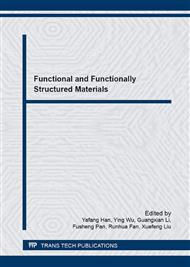[1]
L.M. Goncalves, P. Alpuim, A.G. Rolo, J.H. Correia, Thermal co-evaporation of Sb2Te3 thin-films optimized for thermoelectric applications, Thin Solid Films. 519 (2011) 4152-4157.
DOI: 10.1016/j.tsf.2011.01.395
Google Scholar
[2]
N. Romeo, A. Bosio, R. Tedeschi, A. Romeo, V. Canevari, A highly efficient and stable CdTe/CdS thin film solar cell, Solar Energy Materials & Solar Cells. 58 (1999) 209-218.
DOI: 10.1016/s0927-0248(98)00204-9
Google Scholar
[3]
S.B. Hu, Z. Zhu, W. Li, L.H. Feng, J.Q. Zhang, L.L. Wu, Band diagram construction of CdTe/Sb2Te3 interface using synchrotron radiation, Solar Energy Materials & Solar Cells. 134 (2015) 329-333.
DOI: 10.1016/j.solmat.2014.10.050
Google Scholar
[4]
A.V. Kolobov, P. Fons, A.I. Frenkel, A.L. Ankudinov, J. Tominaga, T. Uruga, Understanding the phase-change mechanism of rewritable optical media, Nature Materials. 3 (2004) 703-708.
DOI: 10.1038/nmat1215
Google Scholar
[5]
H.J. Zhang, C.X. Liu, X.L. Qi, X. Dai, Z. Fang, S.C. Zhang, Topological insulators in Bi2Se3, Bi2Te3 and Sb2Te3 with a single Dirac cone on the surface, Nature Physics 5 (2009) 438-442.
DOI: 10.1038/nphys1270
Google Scholar
[6]
K.B. Tang, Y.T. Qian, J.H. Zeng, X.G. Yang, Solvothermal route to semiconductor nanowires, Advanced Materials. 15 (2003) 448-450.
DOI: 10.1002/adma.200390104
Google Scholar
[7]
S. Kan, T. Mokari, E. Rothenberg, U. Banin, Synthesis and size-dependent properties of zinc-blende semiconductor quantum rods, Nature Materials. 2 (2003) 155-158.
DOI: 10.1038/nmat830
Google Scholar
[8]
X.L. Li, X.R. Wang, L. Zhang, S.W. Lee, H.J. Dai, Chemically derived, Ultra-smooth graphene nanoribbon semiconductors, Science. 319 (2009) 1229-1232.
DOI: 10.1126/science.1150878
Google Scholar
[9]
J.G. Yu, J.C. Yu, W.K. Ho, L. Mu, X.C. Cheng, Simple and general method for the synthesis of multicomponent Na2V6O16·3H2O single-crystal nanobelts, Journal of the American Chemical Society. 126 (2004) 3422-3423.
DOI: 10.1021/ja031795n
Google Scholar
[10]
Y.N. Xia, P.D. Y, Y.G. Sun, Y.Y. Wu, B. Mayers, B. Gates, One-dimensional nanostructures: synthesis, characterization, and applications. Advanced Materials 15 (2003) 353-389.
DOI: 10.1002/adma.200390087
Google Scholar
[11]
H.Y. Chen, H.L. Lu, Y.G. Nie, J.H. Zhang, M.Z. Zhang, Q.Q. Dai, The fabrication of Te nanowires with different orientations by vacuum vapor deposition, Physics Letters A. 362 (2007) 61–65.
DOI: 10.1016/j.physleta.2006.09.088
Google Scholar
[12]
G.S. Cao, C.W. Dong, L. Wang, Z.S. Liu, Selected-control synthesis of Te nanowires and Te/C nanocables by adjusting hydrothermal temperature, Materials Letters. 63 (2009) 1778-1780.
DOI: 10.1016/j.matlet.2009.05.035
Google Scholar
[13]
A.W. Zhao, C.H. Ye, G.W. Meng, L.D. Zhang, P.M. Ajayan, Tellurium nanowire arrays synthesized by electrochemical and electrophoretic deposition, Journal of Materials Research. 18 (2003) 2318-2322.
DOI: 10.1557/jmr.2003.0325
Google Scholar


